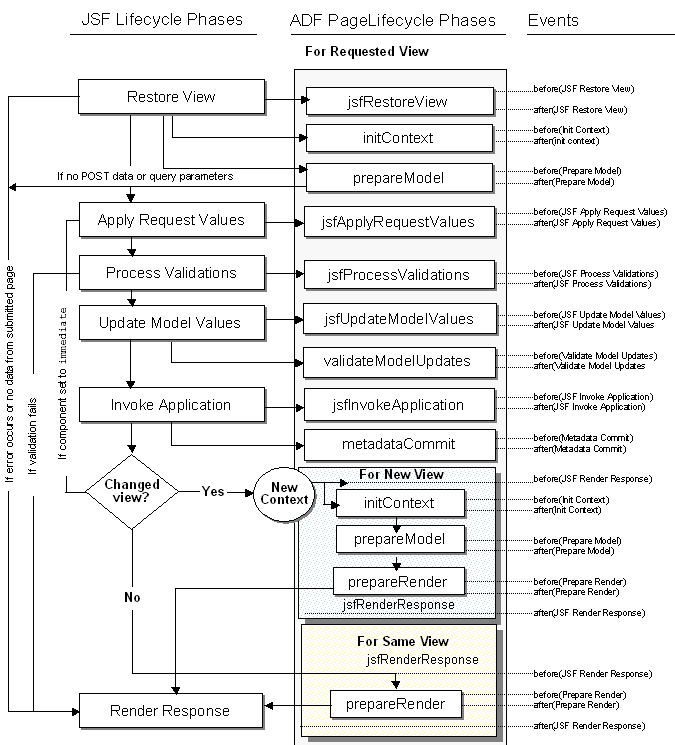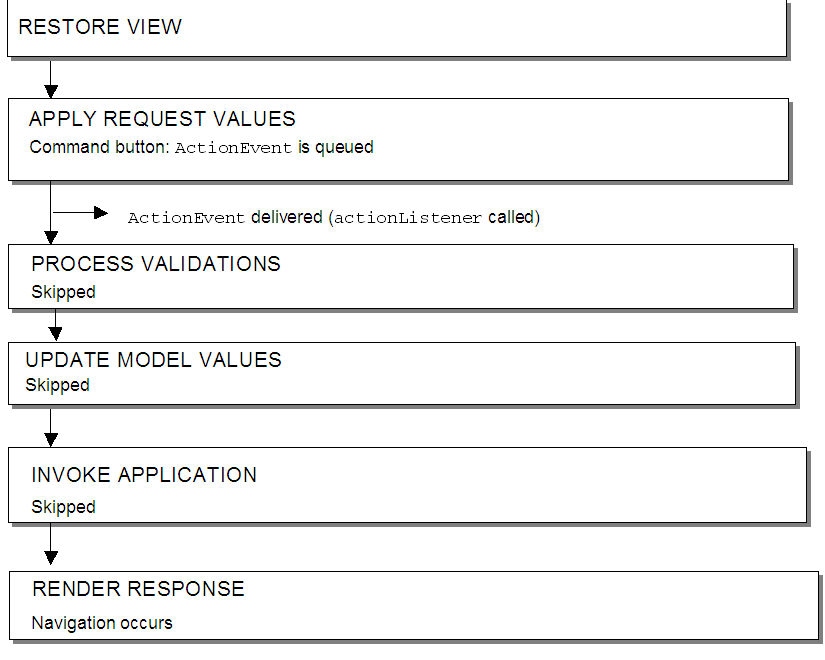ADF Life Cycle Phases:

Apply Request Values: Each component in the tree
extracts new values from the request parameters (using its decode
method) and stores the values locally. Most associated events are queued
for later processing. If a component has its
Process Validations:
Local values of components are converted from the input type to the
underlying data type. If the converter fails, this phase continues to
completion (all remaining converters, validators, and required checks
are run), but at completion, the lifecycle jumps to the Render Response
phase.
If there are no failures, the
What we understand here is that, for input components, by default, the validations are going to be fired in the Process Validations phase. Furthermore, they have a specific order:
1) converters
2) required checks (check if it is required)
3) validators
NOTE: Of course there are some other cases were the required checks are not fired.. but the above is the general idea.
As you may have noticed, in the Apply Request Values phase, it is mentioned that if the component has it's immediate property to true, then the validations will take place in tha phase.
Which means, that they are not skipped.
What we understand here is that validations will fire no matter if the component is immediate =true or not.
But when does the ValueChangeEvent is triggered? Again, according to the documentation:
ValueChangeEvent is an intermediate phase between Process Validations and and updae model Values. This means that ValueChangeListener are invoked right after validations. It does not matter if the component is immediate true or not. The difference lays in the phase those operations will be executed.
The case of the commandButton:
CommandButtons will trigger the validations and valueChangelisteners of inputComponent while pressed. It is the same case weither the the button is partialSubmit and the inputComponent partialTriggered by the button, or the button is not partialSubmit.
If we set the commandButton to immediate true, then some phases are skipped:
According to documentation: When actionSource components (such as a commandButton) are set to immediate, events are delivered in the Apply Request Values phase instead of in the Invoke Application phase. The actionListener handler then calls the Render Response phase, and the validation and model update phases are skipped.
This means that if the button is set to immediate only the ApplyRequestValues phase will be invoked, the Process Validations phase will be skipped.
So, if we will have a selectOneChoice component with autoSubmit=false and immediate=false and a commandButton with immediate=true.
According to what we know so far, the commandButton will invoke the ApplyRequestValues phase and then render response phase. Our selectOneChoise, will invoke the validation and ValueChangeListener in the Process Validations phase.. which in our case, will not be invoked.
So we are bypassing everything...
If we want to invoke validators and valueChangeListeners while having the button immediate=true, we will have to have the selectOneChoice to immediate=true as well!
why? simply because, according to documentation, while having the input component immediate=true, all validators and valuChangeListeners will be shifted to ApplyRequestValues. Which is exactly what we want.
Conclusion: Validators are executed before ValueChangeListeners. They are executed even if the input component is immediate=true. The only change is the which phase they will be executed in.
The combination of commandButton can bypass he validations and valuechangelisteners if it set to immediate=true. We can still have validations and valueChangeListeners triggered if we have the inputComponent to immediate=true. Since the validations and ValueChangelisteners will be triggered in a different phase and more specifically, they will be triggered in the ApplyRequestValues phase.
Source: http://dstas.blogspot.in/2011/12/validator-or-valuechangelistener-adf.html

immediate attribute set to true, then the validation, the conversion, and the events associated with the component are processed during this phase.If there are no failures, the
required attribute on the component is checked. If the value is true, and the associated field contains a value, then any associated validators are run. If the value is true
and there is no field value, this phase completes (all remaining
validators are executed), but the lifecycle jumps to the Render Response
phase. If the value is false, the phase completes, unless
no value is entered, in which case no validation is run.What we understand here is that, for input components, by default, the validations are going to be fired in the Process Validations phase. Furthermore, they have a specific order:
1) converters
2) required checks (check if it is required)
3) validators
NOTE: Of course there are some other cases were the required checks are not fired.. but the above is the general idea.
As you may have noticed, in the Apply Request Values phase, it is mentioned that if the component has it's immediate property to true, then the validations will take place in tha phase.
Which means, that they are not skipped.
What we understand here is that validations will fire no matter if the component is immediate =true or not.
But when does the ValueChangeEvent is triggered? Again, according to the documentation:
ValueChangeEvent is an intermediate phase between Process Validations and and updae model Values. This means that ValueChangeListener are invoked right after validations. It does not matter if the component is immediate true or not. The difference lays in the phase those operations will be executed.
The case of the commandButton:
CommandButtons will trigger the validations and valueChangelisteners of inputComponent while pressed. It is the same case weither the the button is partialSubmit and the inputComponent partialTriggered by the button, or the button is not partialSubmit.
If we set the commandButton to immediate true, then some phases are skipped:
According to documentation: When actionSource components (such as a commandButton) are set to immediate, events are delivered in the Apply Request Values phase instead of in the Invoke Application phase. The actionListener handler then calls the Render Response phase, and the validation and model update phases are skipped.
This means that if the button is set to immediate only the ApplyRequestValues phase will be invoked, the Process Validations phase will be skipped.
So, if we will have a selectOneChoice component with autoSubmit=false and immediate=false and a commandButton with immediate=true.
According to what we know so far, the commandButton will invoke the ApplyRequestValues phase and then render response phase. Our selectOneChoise, will invoke the validation and ValueChangeListener in the Process Validations phase.. which in our case, will not be invoked.
So we are bypassing everything...
If we want to invoke validators and valueChangeListeners while having the button immediate=true, we will have to have the selectOneChoice to immediate=true as well!
why? simply because, according to documentation, while having the input component immediate=true, all validators and valuChangeListeners will be shifted to ApplyRequestValues. Which is exactly what we want.
Conclusion: Validators are executed before ValueChangeListeners. They are executed even if the input component is immediate=true. The only change is the which phase they will be executed in.
The combination of commandButton can bypass he validations and valuechangelisteners if it set to immediate=true. We can still have validations and valueChangeListeners triggered if we have the inputComponent to immediate=true. Since the validations and ValueChangelisteners will be triggered in a different phase and more specifically, they will be triggered in the ApplyRequestValues phase.
Source: http://dstas.blogspot.in/2011/12/validator-or-valuechangelistener-adf.html

